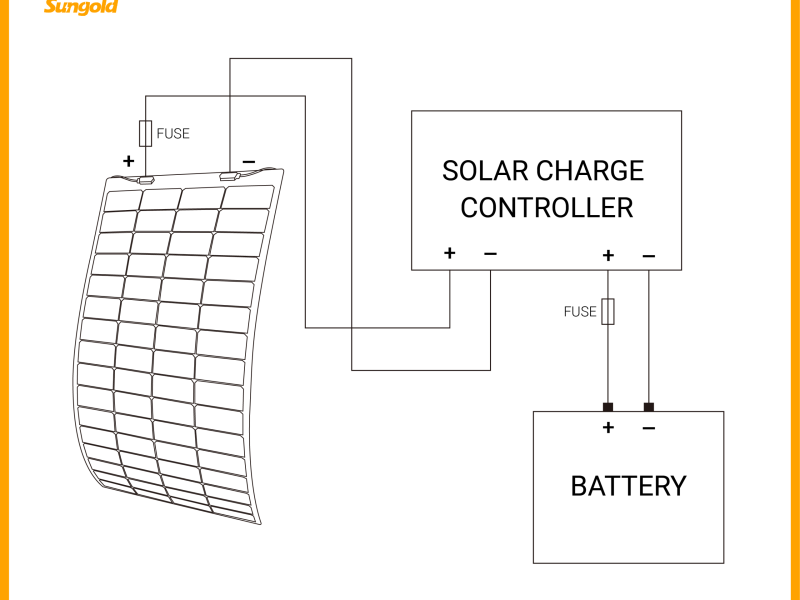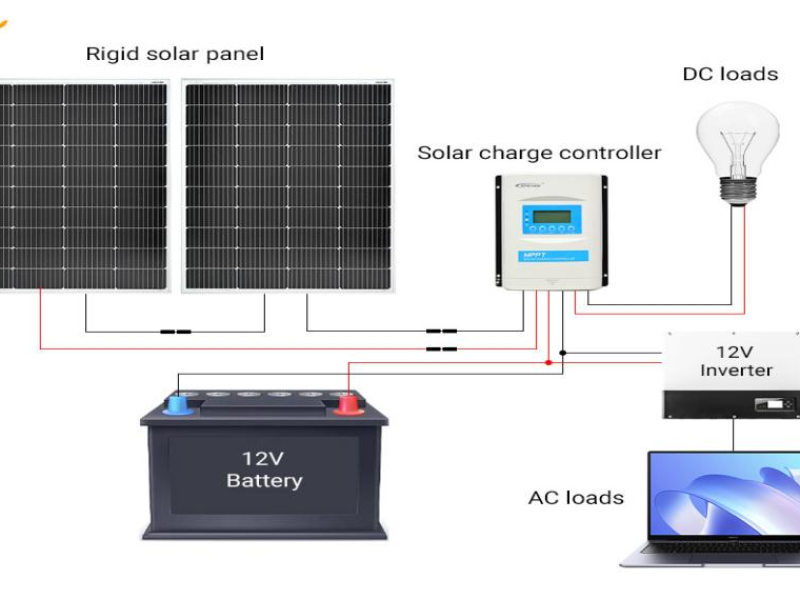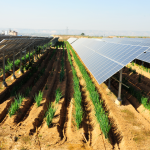Table of Contents
The simplest solar cell charging circuit merely involves connecting the positive terminal of the solar panel to the positive terminal of the battery, and connecting the negative terminal of the solar panel to the negative terminal of the battery. This was the primary method at the time, and it was eagerly embraced for charging batteries!
Before exploring the ways in which solar energy can supplement traditional energy sources, we need to understand the limitations and possibilities of its practical applications. For example, for those who need to quickly replenish power for a variety of devices – whether it’s a motor, a boat, an RV, a home, an electric scooter, or a cabin in a remote area – solar charging has its own unique application scenarios.
Let’s consider a practical scenario: Suppose we’re using a 30-watt solar panel to charge a 100-amp-hour battery under ideal summer sunlight conditions. After a week, the battery’s charge will be close to full. This example illustrates that to fully charge a 100-amp-hour battery within a few days, you would need to deploy at least a 100-watt solar panel.
The primary function of solar panels is to capture sunlight and convert it into usable electrical energy, which is then stored in batteries. The larger the capacity of the battery, the more energy it can store. Therefore, by configuring solar panels, charge controllers, and inverters, you can efficiently connect these devices in series to form a complete solar power system.
This configuration not only effectively manages the captured solar energy but also ensures a stable output of electricity, making the operation of the solar power system more efficient and reliable. Therefore, building and maintaining a well-designed solar collection and storage system are crucial for achieving energy self-sufficiency.
The Solar Panel Wiring Diagram
Wiring Method of Solar Panels
Solar panels primarily charge batteries through two main methods: direct connection and indirect connection. Indirect connection refers to the solar panels being first connected to charging equipment, which is then connected to the battery. In contrast, direct connection involves connecting the solar panels directly to the battery.
When wiring solar panels, the positive lead of the solar panel should first be connected to the positive terminal of the charge controller. Next, the negative lead of the solar panel should be connected to the negative terminal of the charge controller. Then, the positive terminal of the battery should be connected to the corresponding positive battery terminal on the charge controller. After completing these steps, connect the negative terminal of the battery to the charge controller.
Once the solar panels are exposed to sufficient sunlight, the charge controller will activate and emit a signal indicating that the battery is charging. In most solar energy systems, there will be one or more indicator lights flashing during the battery charging process to display the charging status. This method ensures the effective capture and conversion of electrical energy while also protecting the battery from the risks of overcharging or undercharging.

12V Off-Grid Solar Wiring Diagram
With advancements in technology and expanding application areas, users can enjoy almost limitless possibilities. To make the selection process more intuitive, off-grid solar kits tailored to specific needs such as narrowboats, RVs, campervans, or sheds typically utilize 12V systems.
The configuration of such solar systems may vary depending on requirements, with the number and power of solar panels ranging from a single 100W panel to as many as a dozen or more 400W panels. However, despite the diversity in panel configurations, other key components for any 12V off-grid solar kit are relatively fixed. These essential components include, but are not limited to, a charge controller, inverter, and necessary wiring and connectors, all of which are crucial for ensuring the system operates smoothly.
For example, regardless of the number of solar panels, the role of the charge controller is always to regulate the energy collected by the solar panels and ensure safe and effective charging of the battery. The inverter is responsible for converting the direct current into alternating current usable by various household appliances, ensuring the broad applicability of the energy. With such standardized component configurations, off-grid solar kits not only meet basic power needs but also provide stable and reliable performance in various environmental conditions, thereby offering users significant convenience and benefits. (See the diagram below).

How to Use Solar Panels to Charge A Battery?
While solar panels can directly charge a battery, this is only the case sometimes. Solar panels are used to charge batteries. Typically, a charge controller is needed to protect the battery by converting the voltage output from the solar panel to a level suitable for charging the battery. If you are directly using a charge controller to charge the battery, make sure to use the charge controller to manage the flow of current from the solar panel to the battery. In a solar panel system, the charge controller may also be referred to as a charge regulator or solar regulator.
Method 1: DIY Battery Charging from Solar Panel
Using solar panels to charge a battery is an excellent way to generate clean, sustainable energy. Before getting started, it’s essential to install a charge controller that can regulate the voltage transmitted from the solar panel to the battery.
Method 2: Using MPPT Charge Controller
When used correctly, solar panels can be an excellent way to charge a battery. Since the charge controller regulates the power from the solar panel, it is crucial for charging the battery using solar panels. Without a charge controller, your battery may be damaged or even destroyed due to overcharging.
Example
Step 1: Connect the 12V Battery to Your Charge Controller
Check if the 12V battery has wires. If not, you’ll need to purchase 10 or 16 gauge wires to connect them to the charge controller. Connect the stripped end of the positive battery wire to the position terminal and vice versa. Insert the bare wire ends into the charge controller ports and tighten them with a screwdriver.
Step 2: Connect Your Solar Panels to the Charge Controller
Connect the negative solar panel adapter cable to the negative solar panel cable. Perform the same operation for the positive panel cable.
Insert the positive solar input cable into the positive solar PV terminal on the controller and tighten the terminal. Repeat this process for the negative solar input cable.
If you’re connecting multiple panels (which can be done using certain systems like EcoFlow portable solar panels), you’ll need to use solar connectors to series-connect the panels.
Step 3: Check the Connection
After connecting the wires, test the connection by turning on the battery and power system. The charge controller should turn on, indicating that the controller and battery are connected. Monitor the display screen of the charge controller and ensure it generates readings. If you see a blank or zero screen, there may be a connection issue.
Step 4: Position the Solar Panels Under Direct Sunlight
Finally, you’ll need to position the solar panels in the optimal direction to receive the best sunlight. You can mount rigid solar panels on the roof of a vehicle or boat. If you have portable solar panels, use stands to place them on the ground or deck.
What Are The Batteries for Solar Panels?
What kind of battery is used with solar panels?
Among the three main types of secondary batteries, lead-acid batteries are the most popular and commonly used in the automotive industry. The use of nickel-containing batteries is much less frequent. The use of lithium in secondary batteries has become widespread, with many consumer products such as laptops and mobile phones using lithium-ion batteries.
The Types of Batteries for Solar Panels
Lead-Acid Batteries
As the most widely used battery type in solar energy systems, lead-acid batteries have a long history. Invented by French physicist Gaston Planté in 1859, they generate electricity through a chemical reaction between lead and sulfuric acid. These batteries are not only cost-effective but also suitable for large-scale storage applications, especially in solar power systems, where they can charge during sunny days and provide stable power supply during nights or cloudy weather.
Deep-Cycle Batteries
Deep-cycle batteries are designed for frequent charging and discharging cycles without performance degradation, making them ideal for solar energy systems. These batteries can accumulate solar energy during the day and release stored energy when needed, making them suitable for continuous and high-intensity usage requirements.
How to Select battery for solar panel
What To Consider When Selecting A Solar Storage Solution?
Which deep cycle battery is best for me?
Do lithium batteries charge faster than flooded lead acid batteries?
How to Size Solar Panel Batteries?
How many solar power batteries do I need for my solar system?
Is 12V enough for my solar system? What about 24v or 48v?
Final Thoughts
If you’re looking to break free from the grid and embrace a greener or more sustainable lifestyle, using solar panels to charge batteries is a great option. Whether it’s your phone, independent batteries while camping, or small electronic devices powering your van travels, solar energy is both clean and practical. This article explores charge controllers, solar batteries, solar panels, and how to charge batteries using solar panels.
























